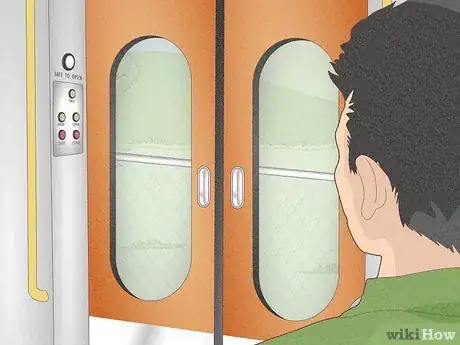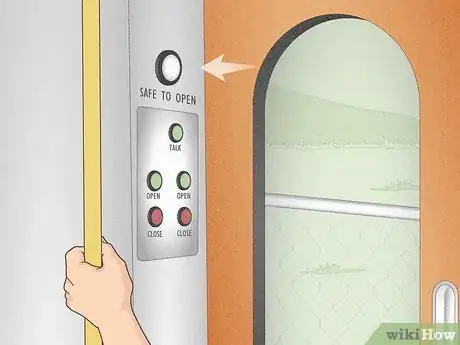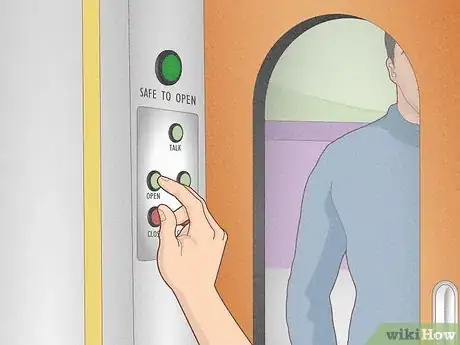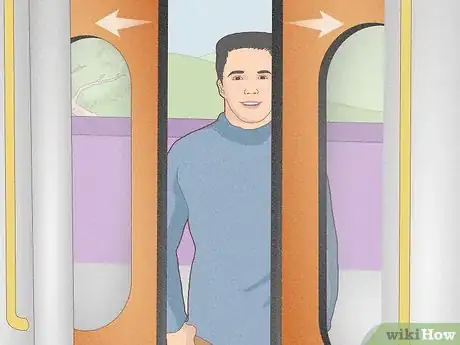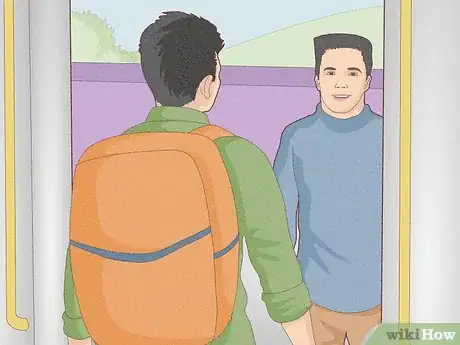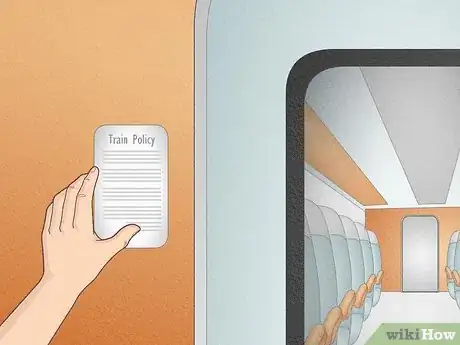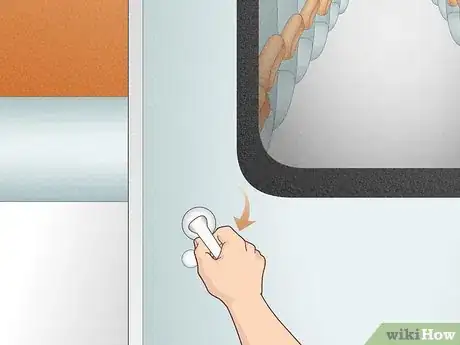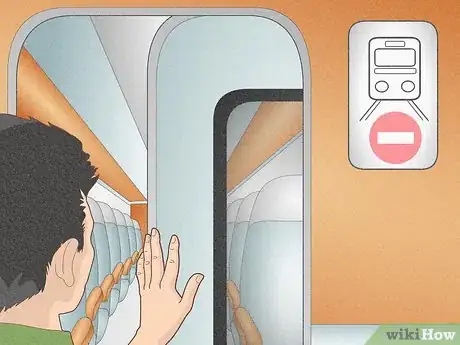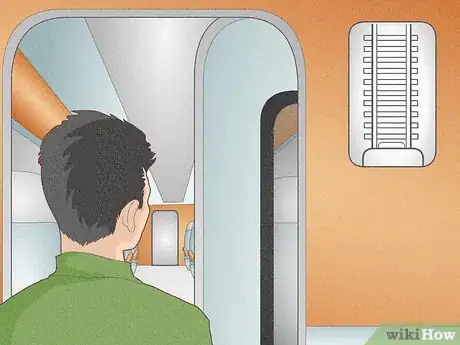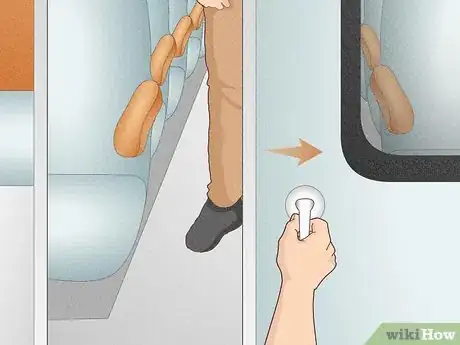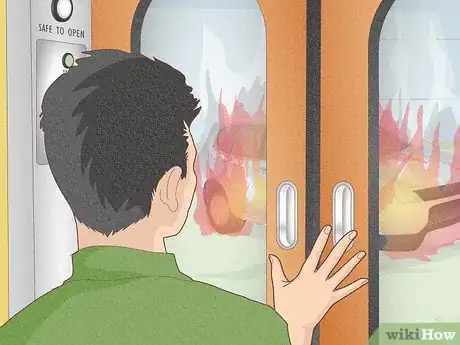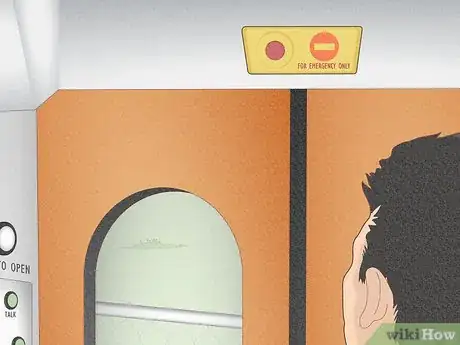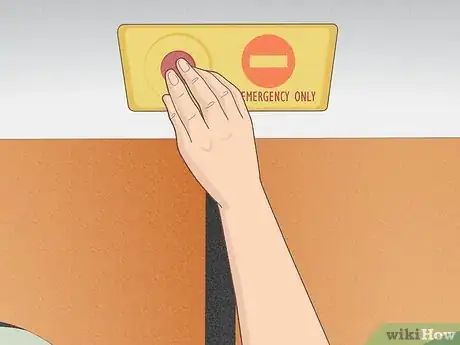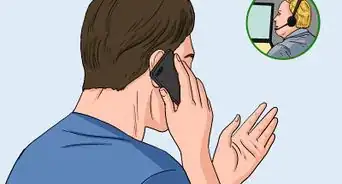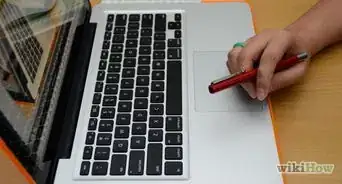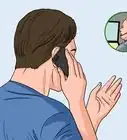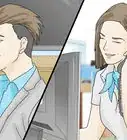X
This article was co-authored by wikiHow Staff. Our trained team of editors and researchers validate articles for accuracy and comprehensiveness. wikiHow's Content Management Team carefully monitors the work from our editorial staff to ensure that each article is backed by trusted research and meets our high quality standards.
This article has been viewed 34,488 times.
Learn more...
Generally, you won't have to worry about opening train doors because the train operator opens them automatically. Some trains, however, require you to use a button or handle to open the door. You may also need to open doors to cross cars or to exit the train in an emergency. Just locate the handle or button and follow any posted instructions.
Steps
Method 1
Method 1 of 3:
Opening Entry and Exit Doors
-
1Check for buttons or handles on or near the doors. Some trains will have buttons or handles that let you open and close the doors. On other trains, the operator may be the one who controls when the doors open and close. Check to see if there are handles or open and close buttons on or next to the train doors.
- These buttons will generally indicate their function with text on or near the button such as “press to open,” or “open” and “close.”
- Train door handles are often either bars that will pivot left and right or indentations built directly into the door that will allow you to slide it open and closed.
-
2Look for lights or signs indicating you can open the door. Many times, a train will have an indicator light or sign letting you know it’s time to open the door. These are commonly above or next to the door. They may also come in the form of an announcement over the train’s sound system.
- If the train has an indicator, do not attempt to open the door until the light is illuminated or the announcement has been made.
Advertisement -
3Open the door when the train comes to a complete stop. If the train uses buttons or handles to open and close the doors, wait until the train comes to a complete stop. Then, press the button or move the handle to open it.[1]
- Often, train doors have sensors that will not allow the door to open before the train has fully stopped.
-
4Wait for the operator to open the doors if the train has no handles or buttons. If your train has no handles, buttons, or other opening mechanisms, the train operator or attendant will likely open the door. Wait for them to do so. Trying to pry open a train door could lead to injury for you and mechanical malfunctions for the door.[2]
-
5Enter or exit the train quickly. Once the door is open, try to get on or off the train as efficiently as possible, keeping in mind that others also need to do the same. Step to the side of the doorway once you’re through to ensure that other passengers can also get on or off the train as they need.[3]
- If you are entering the train, allow exiting passengers to disembark, first. This ensures a smooth, quick transit process for everyone.
Advertisement
Method 2
Method 2 of 3:
Using Doors Between Cars
-
1Review the train’s policy regarding crossing cars. Different train lines have different rules about crossing between cars. Generally, your train will have signs or posters displayed if crossing between cars is prohibited or restricted. Be sure to read the posted signage fully to understand if and when you are allowed to go between cars.[4]
- Some trains will allow you to cross between cars, but only when the train is stopped. Crossing when the train is in motion may result in being forced to leave at the next stop and/or a fine.[5]
- The same train line may have different rules regarding crossing cars for different train models. Do not assume that just because you’ve crossed cars on that train line before that it is permitted on every train.
-
2Check to see if the door can open. Not all trains have doors between cars. Even if they do, some doors may be permanently locked. Check to see if your train car has a door that connects it to the next car. If it does, look for a button, handle, or lever that will allow you to open the door. Also, remember that many trains now have proper gangways between cars, meaning a crossing is safe at all times. This tends to only be the case for mainline trains but some subways also may have it.[6]
-
3Open the door while the train is stopped. If possible, try to wait until the train has stopped to cross cars. Waiting until the train stops means that this is when the train is most stable. This minimizes your chances of tripping or injury.[7]
-
4Wait until the train is on flat tracks if you need to cross while moving. If you cannot wait until the train is stopped, wait until the train is on a straight, flat stretch of tracks. This will make moving between cars easier as turns and inclines are more likely to disrupt your balance.
-
5Use the button or handle to open the train door and cross. Once the train is completely stopped or is on a safe stretch of track, use the button or handle to open the door to exit the car. A corresponding button or handle will be on the door to the next car so that you can get in.[8]
Advertisement
Method 3
Method 3 of 3:
Getting Doors Open in an Emergency
-
1See if any dangers are present outside the train before opening the doors. Never leave a train without the train crew or emergency services telling you to. The safest place to remain is usually on the train. Unless there is immediate danger in your train car e.g. a fire, or smoke then you should stay put. Before you try to open the doors in an emergency situation, make sure it is safe to do so. Listen for instructions from your train operator to see if there are dangers such as overhead wires, electrical 3rd and/or 4th rails, debris, embankments, and adjacent running lines.[9]
-
2Locate the emergency button, knob, or pull. Almost every train has a way to open the doors in case of an emergency. On most rolling stock, there is an Emergency Door Release Handle (or Egress) that will stop the train after they're pulled. keep in mind that the driver is able to over-ride this for a brief period to avoid stopping in an unsafe or unsuitable location. Some trains' Egress handles will not apply the train brakes, in that case, look for an emergency stop button, knob, or pull-chain located next to or just above the door (there may also be some in the seating area above the windows and in bathrooms). Look for signage indicating the emergency open mechanism. These may read, “pull to open,” or “push to open.”
- Often, these will also be recessed so that people do not accidentally pull, push, or hit them.
-
3Push the button or pull the lever. Once you have determined the situation is safe, push the emergency open button, pull the knob or lever as the signage in your train indicates. In some cases, this may only open the doors partially. You may have to manually push or pull the doors completely open if that is the case. Only exit the train on the cess side (the side with no tracks). If this is not possible, take EXTREME care when getting down. Avoid tripping on the tracks by marching across them and always be alert for trains as trains can be completely silent when in loud areas.
Advertisement
Community Q&A
-
QuestionThe train I went to did not have door knob how do I get in? Am I trespassing?
 Hugo BilliauCommunity AnswerNo, entering a train is not trespassing as long as you have a valid ticket or entered the platform legitimately, and that it is a passenger service. Trespassing means to enter an area without authorization. By buying a ticket (for example, the Metro-North) or paying to enter the station (for example, the London Underground), you are given permission to be there. Now for the main question, if the door does not have any button or knob, you should assume that the door is a power-operated sliding door or door that the driver/guard operates. These doors should open once the train has stopped (unless the train is not scheduled to stop there) unless the door is defective.
Hugo BilliauCommunity AnswerNo, entering a train is not trespassing as long as you have a valid ticket or entered the platform legitimately, and that it is a passenger service. Trespassing means to enter an area without authorization. By buying a ticket (for example, the Metro-North) or paying to enter the station (for example, the London Underground), you are given permission to be there. Now for the main question, if the door does not have any button or knob, you should assume that the door is a power-operated sliding door or door that the driver/guard operates. These doors should open once the train has stopped (unless the train is not scheduled to stop there) unless the door is defective. -
QuestionIf your arm is caught in closing doors at a station, are there automatic sensors to save your arm from injury?
 Hugo BilliauCommunity AnswerModern rolling stock is equipped with sensors that can tell when something is trapped. However, older trains do not have this feature and could cause some injury. If something is trapped in these older doors, pull the Egress handle to disable the door.
Hugo BilliauCommunity AnswerModern rolling stock is equipped with sensors that can tell when something is trapped. However, older trains do not have this feature and could cause some injury. If something is trapped in these older doors, pull the Egress handle to disable the door.
Advertisement
Warnings
- Do not use a passcom (emergency alarm) or egress (emergency door release) when there is no emergency, the law in some countries means that you can be fined for doing so. This is because this could result in the train being stopped, which can cause delays.⧼thumbs_response⧽
- Do not evacuate the train without instructions from the train crew or emergency services unless all of the following apply: you are unable to contact the train crew, or you know that they are incapacitated, you do not have time or the ability to contact the emergency services by phone, you are facing a grave emergency e.g. a major fire which poses an imminent and real threat to life and/or limb unless the train is immediately evacuated without delay.⧼thumbs_response⧽
Advertisement
References
- ↑ http://www.metrotrains.com.au/new-to-metro/
- ↑ https://businessmirror.com.ph/lrmc-reminds-commuters-dont-forcibly-open-lrt-1-train-doors/
- ↑ http://www.metrotrains.com.au/new-to-metro/
- ↑ http://www.nytimes.com/1983/06/06/nyregion/new-york-balks-at-us-bid-to-end-all-crossing-between-subway-cars.html
- ↑ http://web.mta.info/nyct/rules/TransitAdjudicationBureau/rules.htm
- ↑ http://www.transitchicago.com/rules/
- ↑ http://www.transitchicago.com/rules/
- ↑ http://www.transitchicago.com/rules/
- ↑ http://web.mta.info/mnr/html/mnrsafety.htm
About This Article
Advertisement
